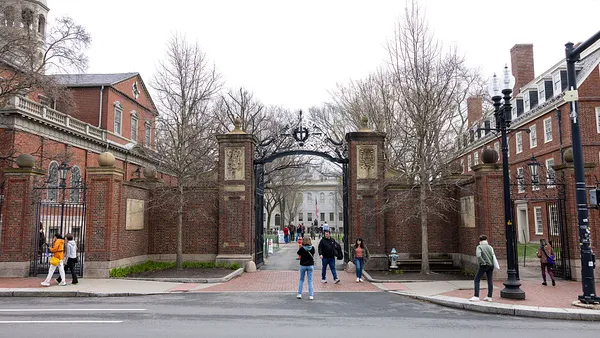Dive Brief:
- The Senate on Thursday approved a $1.4 trillion appropriations package that boosts spending for certain higher education priorities, such as Federal Work-Study and minority-serving institutions (MSIs).
- President Donald Trump has until midnight Friday to sign the deal to avoid a government shutdown. It does not follow the cuts in education that the administration initially proposed.
- Education associations and advocacy groups, including researchers who were initially concerned about Trump slashing their funding, have publicly praised the budget.
Dive Insight:
Trump had recommended a $7.1 billion cut, amounting to a 10% year-over-year decrease in spending, for the U.S. Department of Education in his original fiscal year 2020 budget proposal put forth in March.
At the time, the administration signaled it wanted to prioritize workforce development, requesting Congress direct funding to career and technical education programs.
Trump’s plan called for reworking the Federal Work-Study program to refocus on career-oriented training, though it also had significant cuts to the program.
The draft budget proved deeply unpopular among organizations such as the American Council on Education (ACE). Ted Mitchell, ACE’s president, blasted the administration when the proposal was released, calling the myriad cuts “draconian” and a poor investment in financial aid and research.
The Senate on Thursday passed the twin bills that make up the finalized budget. The final deal appears to have eased the initial concerns of those groups, which drew particular attention to the expansion of Pell Grants.
The budget brings the maximum Pell award up to $6,345, a $150 increase.
Funding for Federal Work-Study will increase by $50 million, for a total $1.2 billion, which is $680 million more than Trump’s request. The Federal Supplemental Education Opportunity Grant (SEOG) program, another form of federal student aid, was approved for $25 million more, bringing it to $865 million. The president had tried to eliminate the program altogether.
Those increases “would boost affordability, helping students access and excel in higher education,” Peter McPherson, president of the Association of Public and Land-grant Universities (APLU), said in a statement after the U.S. House of Representatives passed the spending package.
Overall, the budget gives $72.8 billion in discretionary appropriations to the Education Department. Other higher education initiatives will be funded as follows:
-
$325 million will be set aside for historically black colleges and universities. That’s $42 million more than the previous fiscal year and Trump’s proposal.
-
$143 million was designated for Hispanic-serving institutions, a $19 million increase from the 2019 budget. Congress also recently passed a bill, which Trump signed into law Thursday, that will restore $255 million in funding for MSIs and simplify the FAFSA.
-
$37 million for tribally controlled colleges and universities, which is a boost of $5 million.
-
$1.1 billion for the federal TRIO programs, which are designed to identify and provide services for students from disadvantaged backgrounds. Trump had requested the programs’ funding be trimmed back, but Congress gave it a $30 million infusion.
-
$365 million, a $5 million increase for GEAR UP, another program that assists low-income students. Trump’s proposal called for consolidating it into the TRIO programs.
-
$7 million for the Open Textbooks pilot, an increase of $2 million. Trump’s budget proposal didn’t fund this program.
-
$130 million for the Office for Civil Rights (OCR), which is $5 million more than in the previous fiscal year and in the president’s budget proposal. OCR is tasked with ensuring institutions comply with federal discrimination laws and are often known for investigating complaints regarding campus sexual assault.














